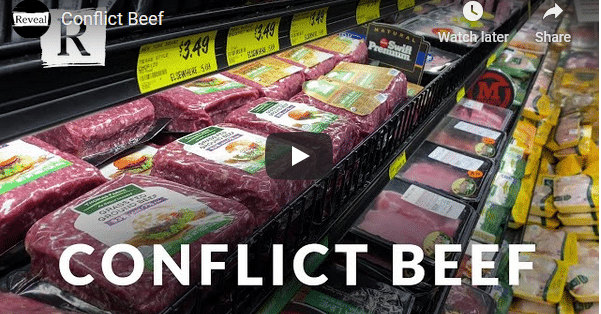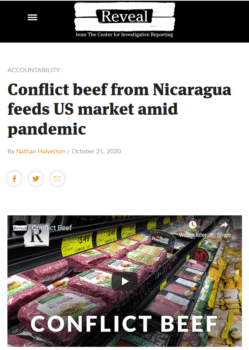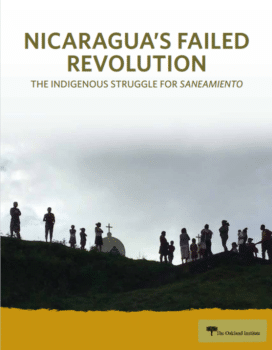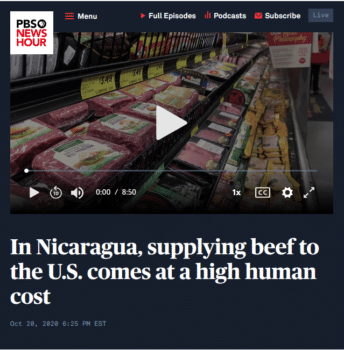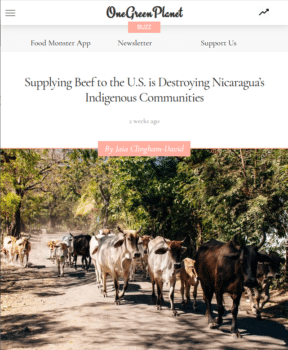Reports by Reveal (10/21/20) and PBS NewsHour (10/20/21) called for a boycott of “conflict beef” from Nicaragua. The Center for Investigative Reporting’s Reveal claims to be “fair and comprehensive” and PBS to be “trusted,” but their misleading and inaccurate reports could have drastic consequences for Nicaragua, at a time when the country is already struggling to deal with U.S. sanctions, the pandemic and the aftermath of two damaging hurricanes. Their argument is that cattle farmers who produce the beef that is exported have in many cases illegally settled territory in the rainforest that belongs to Indigenous communities, and that the government does little to resolve the violent conflict that results.
There are some 40,000 Indigenous families in Nicaragua, and nearly a third of its territory is legally owned and administered by 300 Indigenous communities. Reveal and PBS focus on Bosawás, the largest tropical rainforest reserve in Central America, which has seven territories belonging to Mayangna and Miskitu Indigenous groups, whose land claims have been recognized by the government. (Since 2006, the governing party in Nicaragua has been the socialist Sandinista Front, a longstanding target of U.S. hostility.)
For decades, non-Indigenous (or mestizo) settlers have entered these areas, some “buying” land from Indigenous communities, even though it cannot legally be sold, and others simply taking it. A history of legal, quasi-legal and illegal land occupation, along with intermixing of mestizo families with Indigenous people, have produced a multifaceted, volatile situation, which occasionally causes violent disputes. A local NGO, CEJUDHCAN, in February 2020 counted 40 deaths of Indigenous people over five years connected to land disputes, with further mestizo deaths uncounted.
The remoteness of the area provides ample scope for reports of violence to be distorted for political purposes. For example, in January, Reuters (1/30/20) reported an attack on the Mayangna community of Alal by 80 men, leading to six deaths, ten people being kidnapped and houses being destroyed. Along with local opposition media, the Guardian (1/30/20) and BBC (1/30/20) repeated the story, apparently based on just two phone calls from people claiming that “the state is doing nothing.” Yet police investigated quickly, finding 12 houses burned down and two people injured, but no one dead or disappeared. Mayangna leaders condemned the false reports. Two days later in Wakuruskasna, seven miles from Alal, police found and identified four murder victims. They described a criminal gang responsible for both incidents, capturing one alleged member.
Reveal News journalist Nate Halverson misrepresents a different incident. In February, a young girl bathing in a river in Santa Clara was reportedly hit by a bullet. Halverson repeats the uncorroborated claim that settlers were “sending a message” to the local Indigenous community: “Leave.” He dismisses the police’s conclusion that the injury was caused by another child shooting off a gun, a version corroborated by Lejan Mora, president of Santa Clara’s Indigenous government, who knows the family. Community leaders told FAIR that the family had been bribed to lie about the “attack.”
Halverson claims the homicide rate in the area “soared so high…that it would rank among the most dangerous places in the world.” Lottie Cunningham Wren, who runs CEJUDHCAN, tells Halverson that the 40+ deaths in five years amount to “ethnocide” in which the Indigenous people will “disappear”—an improbable outcome, given that there are 180,000 Miskitu and 30,000 Mayangna people.
To those unfamiliar with Nicaragua, news items about Indigenous groups conjure images of uncontacted tribes in the Amazon. Reveal/PBS calls the area “pristine jungle.” Yet these communities have good roads, access to schools, health posts, local municipal services, and government agricultural and technical support. Romanticized views of forest dwellers create one level of oversimplification. Another, in a region deeply divided between supporters and opponents of Nicaragua’s government, is to report unquestioningly the views of one side, and to suggest ostensibly obvious solutions to land conflicts. Doing so overlooks many obstacles and incorrectly alleges government neglect, ignoring the many advances being made alongside the problems that remain.
All these faults are found in the research behind the Reveal/PBS stories, a report by the Oakland Institute, a California-based progressive think tank that compares the situation of Nicaraguan Indigenous communities with “the peoples and forests in the Brazilian Amazon.” Its author, Anuradha Mittal, has spoken to many Miskitu people aligned with an opposition party, Yatama, but evidently to few if any people from other communities—whether mestizos, Mayangna, Afro-descendants or the many Miskitu who support the government. Glossing over this political bias, she claims to speak for the Indigenous people’s “courageous struggle” against government indifference.
Mittal recognizes that Nicaragua’s widely applauded Law 445 established Indigenous land rights, but she argues that despite subsequent land titling, the government has failed Indigenous people by not taking “the final, crucial step of the land claims process” known as saneamiento—“sanitation”— which in her interpretation “requires clearing the Indigenous territories of non-Indigenous settlers.” But s aneamiento is much more complex than this, as explained below. Nor does Mittal acknowledge the role of corrupt Yatama leaders who failed to advance saneamiento despite controlling the regional government for almost a decade until 2014, while themselves selling land illegally.
Geographer Nora Sylvander, who has studied the issue since 2012, argues that saneamiento could easily “create more problems than it solves,” and may “exacerbate the conflict and violence” rather than curb it. For example, what happens to long-established settlers who have “bought” their land: Do they get replacement land, and if so where? What happens if settlers resist removal with violence—would the government risk lives to carry it out? Guillermo Rodriguez of the Center for Justice and International Law, responding to the Oakland Institute report , said, “It’s a really complex situation. In some places, 90% of the current inhabitants are colonos [settlers].”
Many Indigenous leaders argue that saneamiento is actually working, but could do so more quickly with increased resources and closer political coordination by Indigenous territorial administrations with other levels of government. Both Rose Cunningham, mayor of Waspam, and Miskitu leader Mora described the process to us, in which longer-established settlers may be allowed to stay with community agreement while others, often newcomers, are expelled. In fact, Nicaragua is one of many Latin American countries struggling to develop a viable process of saneamiento, in a Caribbean region which is among the country’s poorest, and where the government assigns limited resources to providing better hospitals, schools and roads.
The crux of the Reveal/PBS pieces is to link the land conflicts in Bosawás, and the alleged failure of government to tackle them, with the production of meat for export. Reveal’s piece is headed “Conflict Beef,” and both it and PBS use pictures of U.S. supermarket meat displays. Both quote Mittal as saying: “The supply chain of beef from Nicaragua is anything but clean.”
This is untrue. The government body responsible for the integrity of the supply chain is IPSA (the Spanish acronym for the Institute for Agricultural Protection and Health). On November 9, IPSA’s director explained to us that they believe their cattle registration and traceability system, approved by the UN Food and Agriculture Organization, is as rigorous as any in Latin America. Through it, IPSA monitors the location and movement of all registered cattle–and only these cattle can enter the supply chain for the export market. Registration of farms and tagging of animals is done by authorized agents, not by producers, and cattle can only be moved, sold and slaughtered if they have the correct documentation. None of the 125,253 registered farms are in the strictly protected areas (“nuclei”) of national reserves. One of the largest exporting companies produced a promotional video in November to explain the safeguards it has in place.
All this is ignored by both Halverson and Mittal. The Oakland Institute report laments the “absence of a nationally coordinated traceability system for cattle,” while Halverson cites an unnamed U.S. Department of Agriculture official saying “that there is no recognized system to trace beef within Nicaragua, meaning importers cannot ensure that their beef wasn’t raised on stolen Indigenous land.” Yet the USDA audits IPSA every two years, and only IPSA-registered cattle are accepted by the six processing plants certified as meeting USDA requirements. None of these are “near the borders of Indigenous lands,” as Halverson claims. He adds that the European Union doesn’t allow beef imports from Nicaragua, seemingly unaware that the EU already has a pilot project with IPSA to ensure the scheme meets its (higher) requirements.
Of the 705,320 cattle registered by IPSA since 2011, just 11% are in the North Atlantic Region, where the Bosawás reserve is located. The region has 13,348 registered farms, but none are in the reserve’s nucleus, and hardly any are in municipalities where land conflicts occur. Waspam, for example, has only 98, and none of them are in southern Tasba Raya, where violence flared in 2015.
Yet clearly there are cattle in the reserve. Although the Oakland Institute report fails to mention it, Miskitu people typically have small numbers of cattle. Many more may be introduced by settlers, either by agreement or illegally. However, while meat (and milk) from these cattle can be sold locally, there are multiple barriers to their entering the export market. In addition to the IPSA system, cattle trucks leaving the reserve have to comply with municipal administrative requirements, present documents at permanent army checkpoints and face random police checks.
A group of cattle farmers interviewed for this article in Siuna, the city closest to Bosawás, explained in detail how these measures prevent cattle kept in the reserve from entering the export market, adding that the army also removes illegal ranchers. Two leaders of the Mayangna nation interviewed for this article described how this is done in coordination with Indigenous forest wardens. While clearly such evictions are only partially effective, it is extremely difficult to see how the remaining ranchers could evade the army and police and breach the IPSA system to sell cattle for export. Local producers say this is impossible, and neither Mittal nor Halverson offer any evidence to the contrary.
The source of the Reveal/PBS material—the Oakland Institute—is openly hostile to the Nicaraguan government, a fact made obvious by the title of its report, Nicaragua’s Failed Revolution. As well as including a very biased account of the violence the country experienced in 2018, the report makes detailed accusations against Sandinista politicians Myrna Cunningham, Rose Cunningham and Carlos Alemán Cunningham, noting that they are from the same (Miskitu) family. It refers positively to the work of CEJUDHCAN without pointing out that its director, Lottie Cunningham Wren, now aligned with the US-supported opposition, is also part of the same family that the Oakland Institute report alleges is involved in corrupt land dealings.
Based on her work with Mittal, Cunningham Wren is also interviewed by Halverson for Reveal/PBS. Two senior Mayangna leaders we spoke to, Arisio Genaro Celso and Eloy Frank Gomez, regard her as simply looking for ways to attack the government while being out of touch with the Mayangna community’s needs. Likewise, Miskitu leader Mora accuses CEJUDHCAN and Cunningham Wren of blatantly lying about events in the region. Fresly Janes Zamora, Miskitu president of the Twi Yahbra territory, said she is benefiting from violence in the area and not seeking solutions. Another person interviewed by Halverson, Camilo de Castro Belli, is described as a journalist, but in fact is a fellow at the Aspen Institute, a neoliberal think tank, a committed supporter of Nicaragua’s opposition and the son of Gioconda Belli, a prominent opposition figure.
Before this piece was written, both Halverson and Mittal were asked for proof of the claimed link between conflicts in Bosawás and beef exports to the US. Although they replied, they offered no proof. A list of suggested corrections to the Reveal article, invited by its editor, was rejected, as was the offer of an article in response to Halverson’s.
Other media picked up the damaging Reveal/PBS piece: Environmental website One Green Planet (11/17/20) linked the story to the enormously different scale of deforestation taking place in the Amazon. KPFA radio in California devoted two episodes of the show A Rude Awakening (11/6/20, 11/13/20) to interviews with Mittal, in which she made generalized attacks on her critics and on the Ortega government, again without offering any proof of her claims. Neither responded to complaints.
By making a completely false link between the land conflicts in Nicaragua and the growth of its meat exports to the United States, ostensibly progressive media are fueling the U.S. government’s regime-change agenda, just as they have in relation to Venezuela. The U.S. pursues this agenda via economic sanctions (renewed by Trump days after recent hurricanes hit Nicaragua) and blatant financial support for opposition groups in the run-up to Nicaragua’s 2021 elections. If the calls for a boycott of Nicaraguan beef in the Reveal and PBS reports were actually heeded, there would be enormous damage to the Nicaraguan economy and to poor communities in Nicaragua. The livelihoods of no less than 140,000 producers and 600,000 workers would be at risk.
Once again, knowingly or otherwise, U.S. media are complicit in attempts by Nicaraguan opposition groups and the U.S. government to undermine Nicaragua’s Sandinista government. Reveal has a deserved reputation in progressive circles for its work in exposing immigration abuses, conditions faced by Amazon workers and other issues: It should pay much more careful attention to the sources of its reports on Nicaragua.

